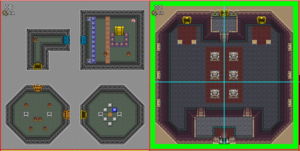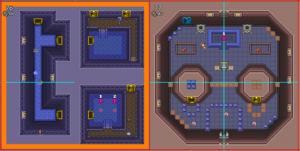Difference between revisions of "EG Map"
From ALttP Speedrunning Wiki
(→Terminology) |
|||
| Line 22: | Line 22: | ||
== Terminology == | == Terminology == | ||
| − | === | + | ===Supertiles & Subtiles=== |
| − | === | + | [[File:Supertile Demonstration.png|thumb|Two adjacent Supertiles on the EG Map. The right Supertile is a single large room, but the left one is divided into 4 Subtiles]]The underworld is made up of a grid of 256 "Supertiles." Supertiles can be organized in a few different ways. They can be an entire room to itself, or it can be divided into smaller rooms called "Subtiles." There can be up to 4 Subtiles within a Supertile. |
| + | |||
| + | In normal gameplay, the difference between these divisions rarely matters, however with glitches, it's important to know that the routines for transitioning between Supertiles and transitioning between Subtiles are different. [[Door Glitches|Transition Corruption]] glitches will behave differently depending on which type of transition the player is using. Additionally, the player can interact with Supertile transitions while in [[Exploration Glitch|EG]] or through clipping. | ||
| + | |||
| + | ===Quadrants=== | ||
| + | |||
| + | [[File:Quadrant Demonstration.png|thumb|Two adjacent Supertiles on the EG Map. The right Supertile is a single large room. Every Supertile-sized room is made up of 4 quadrants. The left Supertile has 3 Subtiles -- two small rooms and a long room. The long room is divided into two quadrants.]]Quadrants are invisible boundaries that divide Supertiles. The game tracks which quadrant Link is in within a Supertile and uses this data when Link transitions. Through [[Door Glitches|Transition Corruption]] glitches, the game may regard Link as being in a different quadrant than he actually is, which can make transitions behave in unusual ways. | ||
=== Wrapping === | === Wrapping === | ||
Revision as of 17:38, 25 May 2021
The EG Map, sometimes also called the Underworld map, is a map displaying the true arrangement of all the game's indoor rooms. In normal gameplay, the game hides the fact that all the rooms are on the same map. However, through using glitches, the organization and mechanics of the overall map become important to understand.Contents
Fully Annotated Map
A fully annotated version of the EG Map can be found here: File:EG map fully annotated.png
This map has a wealth of information regarding the mechanics of the EG Map. Here is a key:
- Red Borders: Supertile Boundaries
- Cyan Borders: Quadrant Boundaries
- Hex Number in top left corner of Supertiles: Room ID
- Hex Number next to Falling Link: Pit Destination
- Supertiles with Green Borders: Supertiles that set Strong EG
- Supertiles with Orange Borders: Supertiles that set Weak EG
- Supertiles with Yellow Borders: Supertiles that kick Link in-bounds
- Numbers on doors and chests: Reveal the organization of this data within a Supertile. This is relevant for Transition Corruption glitches, especially Data spoofing.
- Red Doors: Shutter Doors that are inaccessible to Link -- in other words, a one-way door.
- Orange Doors: Auto Doors. These are shutter doors and bombable doors that Link can access and use.
- Blue Doors: Locked Doors
- Yellow Doors: Normal Doors
Terminology
Supertiles & Subtiles
The underworld is made up of a grid of 256 "Supertiles." Supertiles can be organized in a few different ways. They can be an entire room to itself, or it can be divided into smaller rooms called "Subtiles." There can be up to 4 Subtiles within a Supertile.
In normal gameplay, the difference between these divisions rarely matters, however with glitches, it's important to know that the routines for transitioning between Supertiles and transitioning between Subtiles are different. Transition Corruption glitches will behave differently depending on which type of transition the player is using. Additionally, the player can interact with Supertile transitions while in EG or through clipping.
Quadrants
Quadrants are invisible boundaries that divide Supertiles. The game tracks which quadrant Link is in within a Supertile and uses this data when Link transitions. Through Transition Corruption glitches, the game may regard Link as being in a different quadrant than he actually is, which can make transitions behave in unusual ways.


